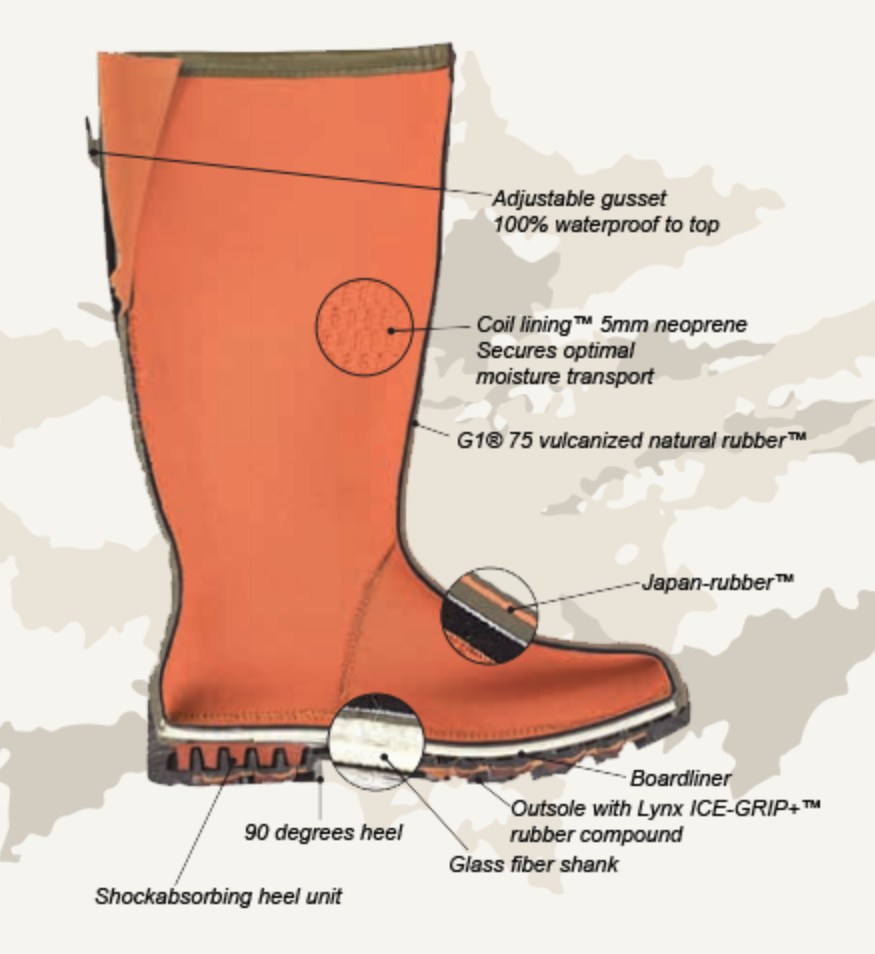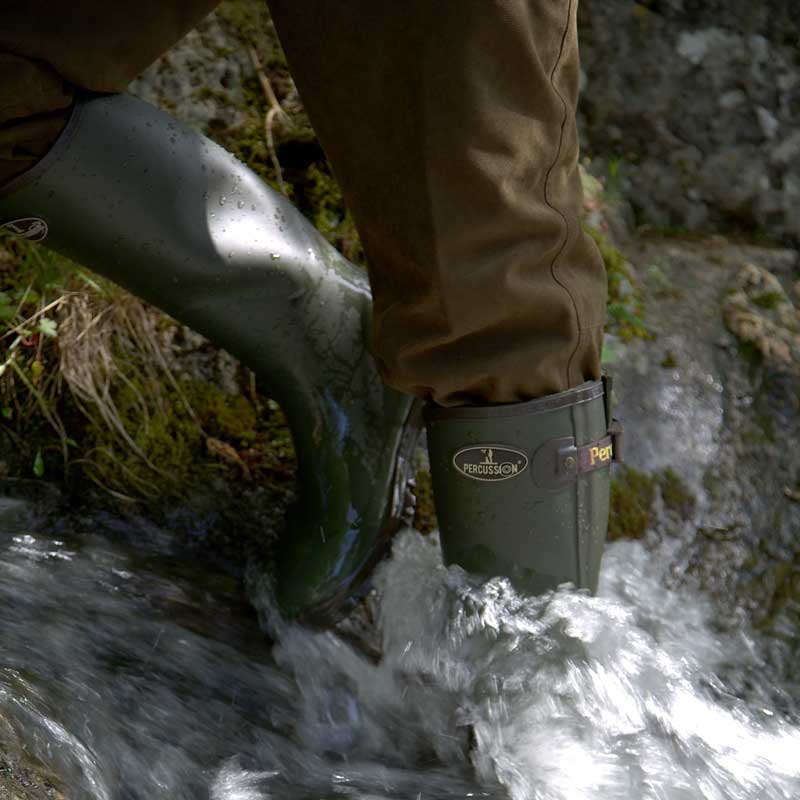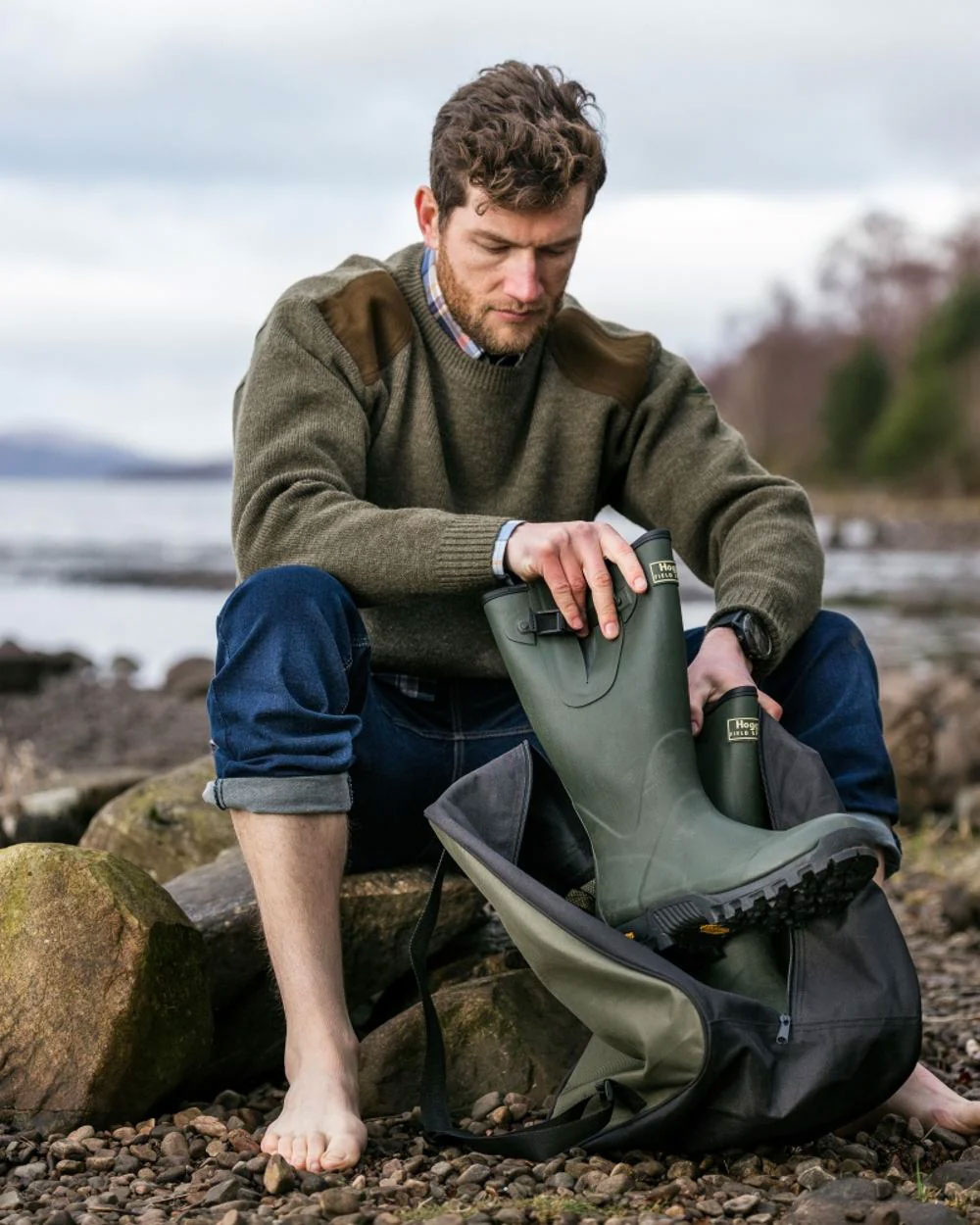Filter by Topic:
Posted by Bethan on Jan 15, 2024
Many people working outdoors or enjoying the outdoor environment often consider wellies as essential footwear. Nowadays, you see people wearing wellies almost everywhere, from music festivals to gardens and even on fashion runways.
This guide provides useful information about the features of wellington boots and what to consider when purchasing a pair.
View our full range of wellington boots >
Where will you wear your wellies?
Wellies, also known as wellington boots or rubber boots, are versatile footwear suitable for various occasions and activities. Here are some places and activities where you can wear wellies:
- Rainy Days: Wellies are perfect for protecting your feet from rain and puddles. Grab a pair of wellies for rainy days to keep your feet dry and comfortable.
- Gardening: If you are tending to your garden or working in a muddy outdoor space, you will need a good pair of garden wellies that provide excellent protection against dirt and moisture.
- Festivals: Many people wear wellies for music festivals, especially those held in outdoor venues where the ground might be muddy. They offer protection and are easy to clean.
- Camping: Wellies are a practical choice for camping trips, especially in wet or muddy conditions. They keep your feet dry and are easy to slip on and off.
- Fishing: If you enjoy fishing, wellies are a great choice to keep your feet dry while standing near water.
- Beach Excursions: Wellies can be useful for walking the dog on the beach, especially if the tide is out and there's soft or wet sand.
- Farming & Agricultural Work: When visiting a farm, it's often advisable to wear a good pair of farming wellies to protect your feet from mud, animal waste, and other debris.
- Hunting & Shooting Wellies: You may find yourself walking for miles through rough, muddy ground. Plenty of support, comfort and waterproofness is key when out game shooting
- Snow and Winter Activities: While traditional winter boots typically offer insulation, some wellies lack this feature. However, they can still be suitable for light snow and wet conditions when paired with thick socks. In more extreme winter conditions, opting for warm wellies becomes more appropriate.
- Dog Walking Wellies: These are excellent for walks with your furry friend, especially when you have to pull them out of the wettest and muddiest stream they can find!!

Remember, whether wellies are a good fit for a specific activity depends on the features of the boots, like insulation, tread, and height. Always think about the environment and conditions to make sure you have the right footwear.
Things to consider before buying a pair of Wellingtons
When looking to purchase a pair of wellington boots, it's essential to carefully consider various factors to ensure you make the right choice for your needs.
Firstly, determine the primary purpose of the wellies. Are you buying them for general outdoor use, gardening, hunting, fishing, festivals, or specific activities like farming? The intended use will guide your decision.
Pay attention to the material of the boots. Typically, manufacturers use rubber to make Wellington boots, but some may incorporate additional materials like neoprene for insulation.
Wellington Boots Lining
What to consider?
When considering a new pair of wellington boots, choosing the correct lining is just as important as choosing the right outer. If the internal lining of the boot is not suitable for the environment you find yourself in, it’s likely there will be an impact on how long you feel you can stay outdoors!
Some customers find that neoprene-lined wellies are not suitable when out and about in warmer climates as their feet can get hot, whereas cotton lined wellies are less likely to be suitable for colder environments.

Wellington Boots with Neoprene Lining
Consider insulation, especially if you plan to use the boots in cold weather. Wellies with insulation are crucial for activities like hunting or any winter outdoor work.
Lining refers to the internal lining of the wellington boot. Many traditional wellies have a traditional rubber inner. However newly designed boots now offer comfortable neoprene, fur and fleece linings. If you are planning on working in cold environments, then a neoprene wellington boot may be your ideal choice.
As comfort and durability are key features needed in a pair of wellington boots, a neoprene lining may be the answer.
A synthetic rubber, akin to the material used in diving suits and known as neoprene, lines these boots. Neoprene technology has fantastic temperature control capabilities and is flexible and soft.
Some key benefits of neoprene lined wellies are:
- warmth – trapping warmth within the boot
- comfort – cushioned walking
- support – the welly moulds itself around the foot for a great fit
- damp-proof – extra protection from dampness
However, there are some drawbacks of neoprene-lined boots which are:
- they may not be suitable for hotter environments
- they are not washable
- They may be heavier than cotton lined boots
If you suffer from cold feet and are on your feet for a long time, perhaps in wet and muddy conditions, then this type of boot is what you need!
Neoprene-lined wellington boots are great for anyone out in the countryside who does a lot of walking. Pairing this lining with a Vibram sole unit makes this type of boot ideal for farmers, shooters, hunters, or dog walkers.
A sturdy neoprene-lined wellington boot that we recommend is the Goodyear Stream Wellington, with 3.5mm of neoprene lining, offering comfort and warmth. This welly has a sturdy trekking outsole, for traction and grip!
Cotton Linings
Many brands such as Hoggs of Fife, have lined their wellies with a cotton lining. The benefits of a cotton-lined wellington boots, include:
- they are easy to pull on and off – no ‘suction’
- they allow space for thick socks
- they are washproof and fast-drying
- great for all year round wear
A popular choice is the Hoggs of Fife Braemar wellington boot. This boot has a removable, washable cotton insole and a moulded outer sole. They are popular with horse riders and dog walkers.
The drawbacks of cotton-lined wellington boots are:
- wearing wellies in colder environments may leave your feet cold unless you opt for thick socks or boot socks.
- they may lack substantial padding when compared to a neoprene-lined boots
- wearing wellies in hotter conditions may cause feet to sweat.
However, cotton-lined wellies are, for example, just great for stable hands and fisherman alike, as they are ideal for wading through mud and rivers or hosing down those concrete yards!
Some of our more colourful festival wellies now offer a cotton lining, making it easier to slide them on and pull them off.
If you find it difficult to pull your boots off, a cotton-lined wellington boot could be the solution for you.
Rubber Linings
The traditional, ‘budget’ wellington boots have no additional lining but the internal rubber lining offers great flexibility and movement. Some of the benefits of wearing this type of boot are:
- they are cheaper than other boots
- they allow plenty of space for thick socks
- more space to add your own insole and/or wellington bootsox
- they have traditional wide-sole lugs, for good grip
- they are easy to fit and remove
The disadvantage of wearing rubber-lined wellington boots include:
- there may be a ‘suction’ action when pulling off the welly – you may lose your sock!
- they offer little warmth – depending on the thickness of the sock you wear!
- less ‘cushioning’ in the foot
Budget rubber wellies however, when worn with thick socks, are perfect for farmers and farm-hands alike!
Make sure the wellies are completely waterproof. This is particularly important if using them in wet or muddy conditions. Some designs are only waterproof up to a certain point of the boot.
Sole Unit
When out walking for a considerable amount of time, sufficient support and a stable sole-unit is a ‘must’!
When considering a new pair of wellies, remember to check that the soles and insoles will offer sufficient arch support to reduce the possibility of back ache and leg ache. (Especially if you suffer with high arches or flat arches).
Durable and stable sole units such as a Vibram sole unit will offer grip and traction. Vibram is a leading provider of sole units within the sporting industry. Quality non-slip sole units are now in use on walking boots, shoes, and wellington boots as a result.
If you are planning on walking a long distance and you need plenty of support, then a Vibram sole unit may be beneficial. Vibram soles offer great grip and traction.
Many different variations and styles of this type of sole units are available. The key benefits of a Vibram sole unit on a pair of wellies are:
- Outstanding grip on various surfaces
- Enhanced stability and comfort
- Optimal balance of traction and durability
- Being able to stay on your feet for longer!
Wellies with a vibram sole are just perfect for walking making them an ideal choice for farmers and agricultural workers, gamekeepers and shooters!
Rubber soles on wellington boots are popular and many high end brands opt to use a rubber sole unit. Wellington boots made with rubber soles are cheaper to buy than those with other technical sole units, and they have many advantages, including:
- Being slip-resistant
- Being waterproof
- They are durable and hard wearing
A sturdy pair of wellington boots with a traditional rubber sole is perfect for dog walkers!
If you're walking in icy weather conditions and need a reliable sole unit, consider the Lynx ICE-GRIP+™ sole unit. This is an innovative rubber compound for outsoles designed for optimal grip in extreme low temperatures. This patented technology, inspired by the paw grip of the Scandinavian lynx, has undergone extensive testing in harsh winter environments in Northern Europe, ensuring exceptional performance in icy and slippery conditions.
If your work involves standing in various materials such as manure, liquids, chemicals and disinfectants, traditional sole units will degrade and rot away. A wellington boot made from PVC/Nitrile is highly resistant to solvents, fats and greases. Designed for the agriculture industry, the Aqua Tuff Safety Rigger wellington boot by Hoggs of Fife features resistance to animal and vegetable oils and fats, disinfectants, and various chemicals.
Flexible Soles on Wellies
Traditional wellington boots are moulded 'all in one,' featuring a rubber upper and a rubber sole.These wellies are flexible and pliable, and are ideal for festivals and horse riding. People often regard these as 'budget wellies.' The benefits of one-piece moulded rubber wellies are:
- Flexibility
- A one-piece moulded welly
- Comfort
- Lightweight
Wellington boots with traditional rubber uppers and soles are a ‘must’ for festival goers – and indeed for everyday wear!
Sole Pattern
Sole design is an important factor to consider when selecting boots for working. Consider the tread pattern and the design of the sides of the sole unit to see how mud, stones and debris can be pushed into the channels.
The XS Trek Vibram sole unit on the Hoggs of Fife Field Sport wellington boot has been designed to offer outstanding grip and traction. The multi traction lugs are perfect for mountain climbing and rough work which is why this type of sole pattern is suitable for farmers, shooters, hunters and dog walkers. For a closer look of the XS Trek Vibram sole unit check out the video below.
This type of sole design is self-cleaning and anti-slip and is perfect for farmers and stable hands. No more sole clogging, simply hose down at the end of the day.
Check the tread pattern on the soles to ensure good traction, especially if you anticipate walking on slippery or uneven terrain. Traction, grip and comfort is key to a good pair of wellies.

Colour & Design
Gone are the days when wellingtons boots were only available in green. Nowadays, wellies are available in various colours, designs and patterns. From funky wellies for festivals to polka dot wellies for working in the garden.
Consider the height of the boots. Higher boots provide more protection against water and mud, but they may be less comfortable for extended wear.
Focus on fit and sizing. Some wellies come with adjustable features like adjustable buckles for a better fit. Some designs feature a side adjuster and others with a rear adjuster. Rear adjusters are more suitable for farmers as they are less likely to catch when climbing in and out of tractor cabs.
Wellington Boots Calf Size Buying Guide
Do you struggle to find wellington boots that fit comfortably?
Perhaps you have athletic calves and your wellies fit too snuggly? Or, maybe you have narrow calves and your wellies ‘slop around’ your legs. If you suffer like this, then check out our collection of wide-calf adjustable wellies.
Take calf width into account. Some wellington boots come in different calf widths, suitable for various leg shapes comfortably.
Calf size can sometimes be an issue and may be either too wide or too narrow. Our collection includes adjustable wellies which offer an adjustable buckle on the side and you can also choose short length wellies, which are suitable for those of you with wider calves.

Adjustable wellies
From our experience, women tend to struggle to find wellington boots that fit. The boots are not wide enough to tuck your trouser leg in, or you struggle to pull them on because the fit is too tight.
Our collection of adjustable wellies have a built-in adjustable strap at calf level enabling you to adjust the width of fit. Behind the strap, a rubber bellowed tongue prevents rain and mud from entering the welly making them 100% waterproof.
The adjustable strap on the wellingtons for ladies is hidden within the design!
Short Wellies
You could consider a short-length welly which offers great protection from mud, snow and rain but has the advantage of fitting just below your calf. Our collection includes the Gateway Sportsman 12" Short Wellie which is an adjustable short-length welly, perfect for narrow legs!
Wellington Boots with Zips
Wearing wellington boots with zips can offer both benefits and drawbacks. On the positive side, the inclusion of zips can make it easier to put on and take off the boots, saving time and effort. This feature can be particularly convenient when dealing with muddy or wet conditions, as it allows for quick removal without the struggle often associated with traditional pull-on wellies. Additionally, wellies with zips may provide a more customised fit, as wearers can adjust the tightness around the calf to suit their preference.
However, there are some drawbacks to consider. The presence of zips introduces an additional element that could potentially compromise the waterproofing of the boots. If not properly sealed or protected, water may find its way through the zip, defeating the purpose of wearing wellington boots in wet environments. However, many of the top brands of wellies such as Percussion and Goodyear incorporate a gusset behind the zip preventing any water or mud from getting into the boot.
Furthermore, the zip itself may be susceptible to damage or malfunction, leading to potential issues with the boot's functionality. However, investing in a good brand of wellington boots with zips will reduce the likelihood of this happening.
Wellington Boots Accessories
Whether considering buying a pair of neoprene-lined wellies or festival wellies, there are many wellington boot accessories available.
Staying warm and comfortable are the key factors to consider when buying a pair of wellies, and our selection of wellington boot accessories will assist with this.
Insoles for Wellington Boots
Many of the insoles supplied in wellington boots may not be suitable for the shape of your foot. Perhaps you are flat footed or suffer from high arches, back ache or leg ache. If so, the traditional basic insole may be causing these problems and so replacing them with a technical insole may alleviate some of these aches and pains.
Below are five benefits of changing your insoles to make your wellies feel more comfortable:
- fleece insoles will provide warmth
- felt insoles will prevent damp
- performance gel insoles will provide arch support
- sport gel insoles are anti-bacterial and help to reduce foot odour
Wearing footwear with inadequate insoles can lead to various foot problems, of course. Check out our guide Which walking boot insoles for further details.
Wellington Boot Bag
Whether dog walking, farming, walking or shooting, at the end of the day your wellies are likely to be wet and muddy. To prevent clumps of mud and wet puddles appearing in your car footwell, or when you get home, a wellington boot bag is a perfect investment.
Welly boot bags are made from heavy duty materials that are tough and durable. Equipped with a carrying handle, air vents and full zip, these bags will make looking after your wellington boots seem like a breeze. Remember, air vents are essential in a boot bag as they prevent wet, muddy boots from going mouldy and even rotting over time - especially if you have forgotten to clean them after use!
Look for additional comfort features, such as cushioned insoles, arch support, or breathable linings, depending on your preferences and intended use.
Determine your budget for wellington boots. While there are affordable options, investing in a higher-quality pair may offer better durability and performance. If working outdoors all day on hard surfaces, you may wish to consider splashing out on a pair with the added cushioned heel and arch support. These features will help to reduce foot and leg fatigue.
Conclusion:
This wellington boots buying guide aims to provide valuable insights for individuals considering the purchase of these versatile and essential outdoor footwear. Wellington boots, also known as rubber boots, have transcended their traditional utility to become fashionable choices for various occasions.
The guide emphasises the diverse environments where wellies excel, from rainy days and gardening to festivals, camping, fishing, and even winter activities. It highlights the need to think about things like keeping warm, the material inside (like neoprene or cotton), and the type of sole for different purposes.
Whether opting for traditional rubber-lined wellies, neoprene-lined for extra warmth, or those with Vibram or Lynx ICE-GRIP+™ soles for superior traction, the guide offers a comprehensive overview. It also discusses the pros and cons of zipped wellies, highlights the importance of calf size, and introduces accessories like insoles and wellington boot bags to enhance comfort and maintenance.
The guide helps people make smart choices about wellies by considering their personal preferences and the activities they plan to do outdoors.
FAQs
Should you go up in size in wellies?
Selecting the right size for wellington boots is essential for optimal comfort. If you plan to wear thicker socks, going up a size can provide additional room and ensure a comfortable fit, especially in colder weather. Some wellies are available in half sizes, offering a more precise fit for individuals falling between whole sizes. It's important to find a balance between a snug fit to prevent blisters and enough room for toes to move comfortably.
My wellington boots are cold but I can’t afford a new pair of Neoprene boots. What can I do?
If your wellington boots are cold and you can't afford new neoprene ones, consider cost-effective alternatives. Invest in thick, insulating socks or add insulating insoles to provide extra warmth. Layering with sock liners or using disposable toe warmers can also enhance insulation. Warming up your boots before wearing them and choosing the warmest times of the day can further improve their comfort in colder conditions.
Are wellies good for walking?
Wellies are not specifically designed for extended or brisk walking. They may lack the comfort features, arch support, and flexibility found in dedicated walking shoes, making them less ideal for prolonged walks or varied terrains.
Are there Wellington boots for wide calves?
Yes, there are wellington boots designed specifically for individuals with wider calves. These boots typically feature adjustable straps, buckles, or gussets that allow for a better fit around the calf area. Some brands offer wide-calf versions of their popular wellington boot models to cater to a broader range of calf sizes.
What do I need to think about when looking for the right type of wellies for dog walking?
When searching for suitable wellies for dog walking, comfort, fit, and insulation need to be considered. Opt for wellies with waterproof construction and slip-resistant soles to tackle wet and muddy conditions. Choose a height that balances protection and comfort, and ensure the boots are easy to clean after messy walks.
What is the difference between neoprene-lined and regular Wellington boots?
The primary difference between neoprene-lined and regular Wellington boots lies in the lining material used in the interior of the boots. Neoprene-lined wellington boots have an additional layer of neoprene, a synthetic rubber, in their lining. Neoprene provides insulation, offering warmth and comfort, making these boots suitable for colder environments. The neoprene lining also tends to be flexible and soft, moulding around the foot for a snug fit.
On the other hand, regular Wellington boots typically have a traditional rubber inner lining without additional insulation. While they offer waterproof protection and are suitable for various conditions, they may lack the warmth provided by neoprene-lined boots. Regular Wellington boots are often chosen for general-purpose use, where extreme cold temperatures are not a significant concern.
Are there insulated Wellington boots for winter?
Yes, there are insulated Wellington boots specifically designed for winter conditions. These boots feature additional insulation to keep the feet warm in cold temperatures, making them ideal for winter activities. Neoprene-lined Wellington boots, such as the Percussion Full Zip Cambridge welly or the Gateway1 Field Master Neoprene Lined Wellington Boot, are popular choices. The neoprene lining provides excellent thermal insulation, trapping warmth and ensuring comfort in colder weather.
How do I clean and maintain Wellington boots?
Cleaning and maintaining Wellington boots is essential for prolonging their life and ensuring continued functionality.
- Start by removing excess mud and dirt with a soft brush or cloth.
- Rinse the boots with clean water to remove any remaining debris.
- For stubborn stains, use a mild soap or specialised boot cleaner, avoiding harsh chemicals that can damage the rubber.
- Allow the boots to air dry naturally, avoiding direct heat sources like radiators, which can cause the rubber to crack.
- To maintain the boots' flexibility, consider applying a silicone-based rubber conditioner or petroleum jelly to prevent them from drying out.
- Store the boots away from direct sunlight and extreme temperatures.
- Regularly inspect and replace insoles if needed, and repair any visible cracks or damage promptly to ensure the boots remain in good condition.



